Tropical Flowers: [Types, Characteristics and Care]
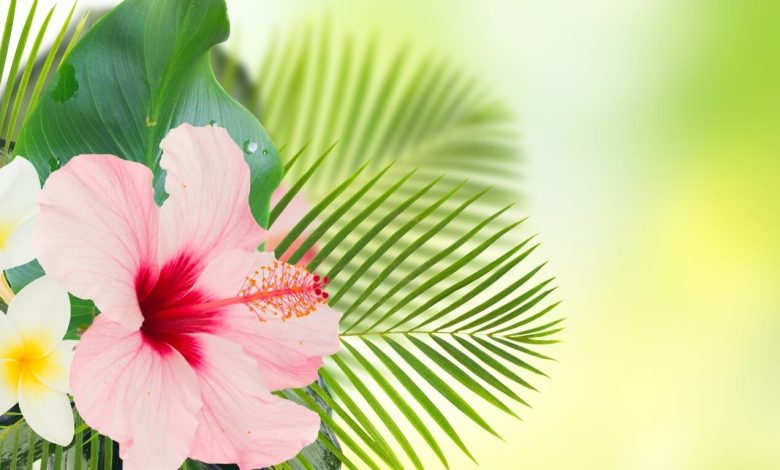
Tropical flowers are made up of the diversity of species that grow in regions near the equator, where they have the necessary warmth and humidity throughout the year.
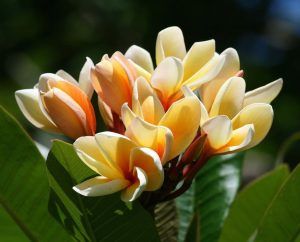 These types of flowers can be grown in more temperate climates, but sometimes they must be placed indoors to avoid frost.
These types of flowers can be grown in more temperate climates, but sometimes they must be placed indoors to avoid frost.
Over the years and with climatic changes, tropical flowers have slowly transformed to take on shapes and colors so cheerful and so vivid that they seem to have been painted by an artist.
orchids
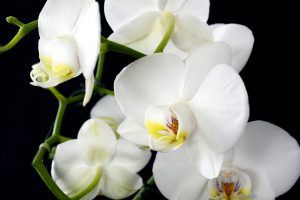 water needs. Once a week when dry.
water needs. Once a week when dry.- Light needs. Lots of light, but not direct sunlight.
- Substratum. Removed and special for epiphytic orchids, it is the best option, as it guarantees good drainage and excellent aeration.
The Orchid is one of the best known and most popular indoor plants, however, its care and needs are a mystery to many. They are characterized by the diversity of colors, sizes and shapes.
Currently, they can be found in many parts of the world, but they do not support extreme climates, neither polar nor desert. Of tropical origin and epiphytic character (it lives in the branches and trunks of trees), the Orchid is used to very specific tropical conditions.
bat flower
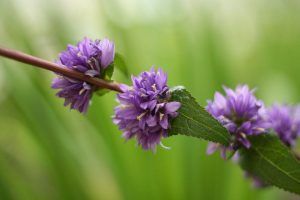 water needs. Regular watering, without letting the substrate dry up.
water needs. Regular watering, without letting the substrate dry up.- Light needs. Lots of light, but not direct sunlight.
- Substratum. Fertile but well drained. Substrate composed of a mixture of 50% pine bark, 40% peat and 10% sand.
Known by its scientific name is Tacca Chantrieri, the bat flower is native to the tropical jungles of Asia. It is also referred to by its colloquial name «bat flower» due to the huge «whiskers» that grow out of the flower.
The whiskers of the bat flower are its way of attracting the attention of birds and insects to help it in its pollination process. They can also mimic the smell of rotting meat to ward off flies.
The main attraction of this plant is its flower, which is an umbel (a set of flowers that are born grouped from the same stem). Each umbel has two bracts that are wing-like structures that can be black, maroon-black, or purplish-black.
plumeria
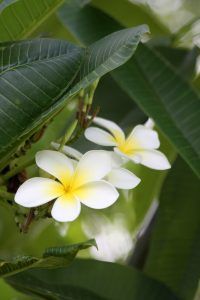 water needs. Abundant watering in spring and summer, rest of the year spaced watering.
water needs. Abundant watering in spring and summer, rest of the year spaced watering.- Light needs. In full light. It needs a lot of sunlight.
- Substratum. Fertile but well drained. Substrate composed of a mixture of organic matter, coarse bark, perlite and coarse sand.
Plumeria, known as «sacuanjoche» are showy flowers usually used in Hawaiian garlands in the Hawaiian Islands. It is also native to the Caribbean, South America, and Mexico.
Plumeria flowers give off a pleasant aroma that is perceived as a combination of jasmine, gardenia, citrus, and spices, and is enjoyed during the blooming period from early summer through fall.
hibiscus
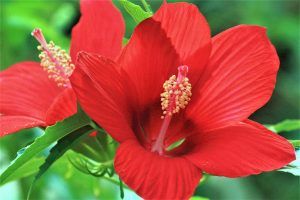 water needs. Abundant irrigation. Little rest of the year.
water needs. Abundant irrigation. Little rest of the year.- Light needs. Lots of light, but not direct sunlight.
- Substratum. Fertile but well drained. It supports sandy soils well. Fertilizers with high levels of potassium and special fertilizer for flowers.
Hibiscus is an easy-care tropical flowering plant native to tropical regions of Asia and the Pacific Islands. Its flowers are commonly reddish-orange, pink or yellow.
But they can also be lavender, bluish, brown, gold, and white. Due to the beauty and caliber of their flowers, as well as their resistance, hibiscuses are common ornamental plants in parks, gardens and both public and private spaces around the world.
Bird from paradise
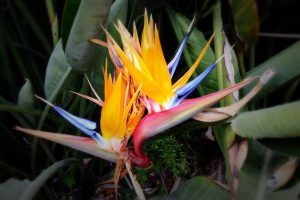 water needs. Regular irrigations. Rest of the year scarce irrigation.
water needs. Regular irrigations. Rest of the year scarce irrigation.- Light needs. Lots of light, but not direct sunlight.
- Substratum. Fertile but well drained. It is recommended that the PH is around 7.5.
The bird of paradise, or «strelitzia», is a flower native to South Africa and is related to the banana because of its woody stems.
It has a spectacular appearance and an interesting growth pattern; the single flower resembles a bird in flight, deep orange with faint blue hues.
The plant can tolerate temperatures as low as 24 degrees Fahrenheit (-4 degrees Celsius) for a short period of time, although the cold will damage the flowers and buds.
The Bird of Paradise, if kept healthy and mature, can produce three dozen flower stems in a year, and the flowers can last up to three weeks if cut.
heliconia
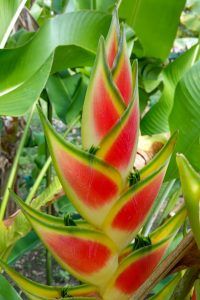 water needs. Abundant, Rest of the year, scarce risks.
water needs. Abundant, Rest of the year, scarce risks.- Light needs. Lots of light, but not direct sunlight. It can be semi-shade.
- Substratum. Fertile but well drained, preferably acidic. A mixture of 60% mulch with 30% perlite and 10% earthworm humus.
The heliconia is a very striking plant due to its spike-shaped inflorescence. It can reach between 4 and 6 meters in height and its leaves are fan-shaped.
The true flowers of heliconias are hidden within the bracts. Heliconias exist in multiple colors, the most common being red, orange and yellow. They are plants native to South America and Central America.
anthurium
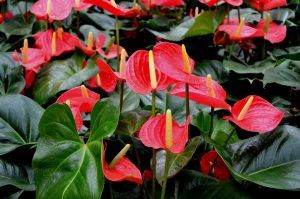 water needs. In winter once a week. Rest of the year spaced irrigation.
water needs. In winter once a week. Rest of the year spaced irrigation.- Light needs. Lots of light, but not direct sunlight.
- Substratum. Composed of a mixture having 50% pine bark, 40% peat and 10% sand. Liquid fertilizer.
The anthurium is a plant native to the tropical part of America, from Mexico to northern Argentina and Uruguay. In Greek its name means «tail flower».
The anthurium is the ideal flower for those who do not have much experience in growing plants, as they require little attention and their inflorescences last for months. Although the anthurium looks like a single flower, in fact, they are a grouping of flowers.
The colored part in the shape of a heart (the spathe) is not a flower, since in reality the reproductive system of the plant is found in the spadix (the protruding stick, normally white).
Abutilon
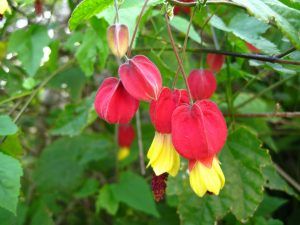 water needs. every 2 or 3 days abundant. In winter spaced watering.
water needs. every 2 or 3 days abundant. In winter spaced watering.- Light needs. Lots of light, but not direct sunlight.
- Substratum. Fertile but well drained. Substrate composed of a mixture of fertile soil, peat and sand inequal parts.
The Abutilon is a genus of plants of the Malvaceae family. In gardening, its hybrids are used above all, with which shrubs with extraordinary and attractive blooms are reproduced.
The leaves of these Abutilon shrubs closely resemble those of some maples. They can reach 2 to 3 meters in height.
begonias
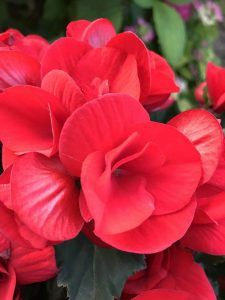 water needs. In winter watering every 7 or 9 days.
water needs. In winter watering every 7 or 9 days.- Light needs. A lot of light. It does not need direct sun.
- Substratum. Fertile but well drained. Substrate composed of a mixture of 1/3 fertile soil and 2/3 peat.
Begonias come from tropical regions in Asia, Africa and South America. It has colorful and very striking flowers, so they are very valuable and used in gardening.
There are about 1,500 species in the genus of begonias which make it a very widespread flower. This type of flower does not require special care for its cultivation.
The name of the begonias genus was given by the botanist Charles Plumier (17th and 18th centuries), who was inspired by Michel Bégon, a former governor of the French colony of Saint Domingue, now Haiti.
bromeliads
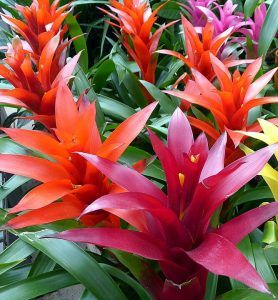 water needs.. In winter little irrigation.
water needs.. In winter little irrigation.- Light needs. A lot of light. It does not need direct sun.
- Substratum. Fertile but well drained. Substrate composed of a mixture of 1/3 fertile soil and 2/3 peat.
Bromeliads are typical of the American continent and there are at least two thousand species, but thanks to their versatility they can be grown in any climate.
Its cultivation indoors is a classic but with good weather they can be taken outside so that with their beautiful leaves and the central rosette or bract, they form part of the tropical design of the garden.
Brugmansias
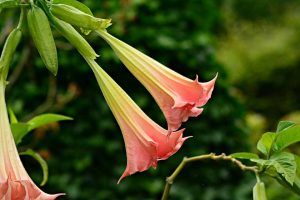 water needs.. In winter little irrigation.
water needs.. In winter little irrigation.- Light needs. A lot of light. Full sun and also or partial shade.
- Substratum. Fertile but well drained..
Brugmansia flowers have showy trumpet-shaped flowers. These are shrubs that reach a height of 3 – 11 m.
Its natural range is the subtropical regions of Mexico, Central and South America.
Cane
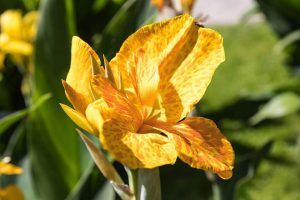 water needs. In winter little or almost no irrigation.
water needs. In winter little or almost no irrigation.- Light needs. Full sun in cold climates. Warm semi-shade climates.
- Substratum. It can be planted in any type of soil; although it always appreciates a good fertilization with manure.
It is a herbaceous and rhizomatous plant, it grows in the tropical and subtropical climate zones of America. Cana is a perennial type flower that has an aerial stem and an underground one.
Its scientific name is canna. It belongs to the cannaceae family. The most common species are: canna indica, canna x generalis, canna edulis, canna coccinea, canna iridiflora, canna hybrida.
Mandevilla
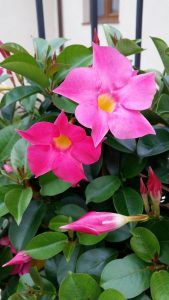 water needs.. In winter, keep the substrate moist and spray its leaves.
water needs.. In winter, keep the substrate moist and spray its leaves.- Light needs. Lots of light, but not direct sunlight.
- Substratum. Requires nutrient-rich, well-drained soil. The substrate can be mixed with coconut fiber or sand.
Mandevillas can be used to recreate a tropical environment. This vine native to South America has intense green leaves and very attractive blooms.
It receives the name of Chilean jasmine and is quite sensitive to frost, so it is recommended to plant it in a protected place. Its sap can irritate the skin, so when annual pruning is done it is necessary to wear protective gloves.
Zingiber spectabile
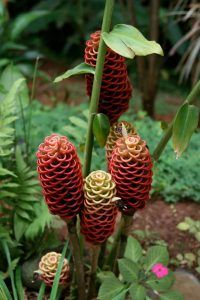 water needs.. In winter reduce the frequency of irrigation.
water needs.. In winter reduce the frequency of irrigation.- Light needs. A lot of light. With partial shade.
- Substratum. It demands moist, nutrient-rich, well-drained soil.
Known as hive ginger, it is a plant of peculiar beauty. It presents a range of colors including yellow, gold, orange and caramel, its leaves are very similar to the leaves of the banana tree.
With the scientific name of Zingiber spectabile, from the Sanskrit «horn shape», this flower alludes to its characteristic color of leaves and the strange shape of the flower.
The zingiber spectabile is a very unusual flower that, due to its characteristic appearance, which resembles a beehive shape, is widely used as an ornamental species.
african moon
 water needs.. In winter reduce the frequency of irrigation.
water needs.. In winter reduce the frequency of irrigation.- Light needs. A lot of light. Full sunlight.
- Substratum. It demands moist, nutrient-rich, well-drained soil.
The African Moon is a pretty annual with numerous narrow leaves that have tooth-like edges and can grow up to 8-12 inches.
The most common colors of this flower are white and yellow, but there are also orange flowers. African moonflower can be grown easily by sowing the seeds in the fall, and making sure to place it in full sunlight.
Bibliography and references
- IHow.es. tropical flowers. Reproduced from: https://www.ehowenespanol.com/flores-tropicales-comunes-lista_175418/
- Agromatic.es. Cultivation of hibiscus or rose of china. Reproduced from: https://www.agromatica.es/cultivo-del-hibisco-o-rosa-de-china/
- Hogarmania.com. Bird of paradise care. Reproduced from: https://www.hogarmania.com/jardineria/mantenimiento/plantas/cubiertas-paraiso-19897.html
- fiorelyshop.com. Tropical flowers. Reproduced from: https://www.fiorelyshop.com/blog/flores-tropicales-6/
- Hogarmania.com. Heliconia care. Reproduced from: https://www.hogarmania.com/jardineria/fichas/plantas/heliconia-bihai-26384.html
- Jardineriaon.com. The Heliconia. Reproduced from: https://www.jardineriaon.com/heliconia.html
- Pisos.com. Care for the anthurium. Reproduced from: https://www.pisos.com/aldia/cubiertas-para-el-anthurium/7983/
- Laguiainmobiliaria.com. The 7 best tropical flowers. Reproduced from: https://www.laguiainmobiliaria.com.mx/las-7-mejores-flores-tropicales-para-tu-jardin/
- Elicriso.it. Abutilon – Care. Reproduced from: https://www.elicriso.it/es/como_cultivar/abutilon/
- Okidiario.com. Begonia care. Reproduced from: https://okdiario.com/howto/como-cuidar-begonia-1079186
- Ecologíaverde.com. Cultivation and care of Begonias. Reproduced from: https://www.ecologiaverde.com/cultivo-y-cubiertas-de-la-begonia-1487.html
- Consultaplantas.com. Indica Cana Care. Reproduced from: http://www.consultaplantas.com/index.php/plantas-por-nombre/plantas-de-la-aa-la-c/165-cubiertas-de-la-planta-canna-indica-achira -o-cana-de-guineas
- Verdecora.com. Mandevilla dipladenia care. Reproduced from: https://verdecora.es/blog/trabajos-dipladenia-mandevilla
- Ecured. Zingiber Spectabile. Care. Reproduced from: https://www.ecured.cu/Zingiber_spectabile

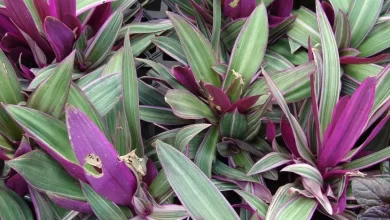
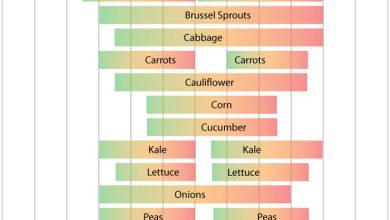
![Photo of How to Fertilize Avocados: [Methods, Dates and Components to Use]](https://www.complete-gardening.com/wp-content/uploads/2022/08/how-to-fertilize-avocados-methods-dates-and-components-to-use-390x220.jpg)
![Photo of How to Make Homemade Organic Compost: [Types and Forms]](https://www.complete-gardening.com/wp-content/uploads/2022/08/how-to-make-homemade-organic-compost-types-and-forms-390x220.jpg)